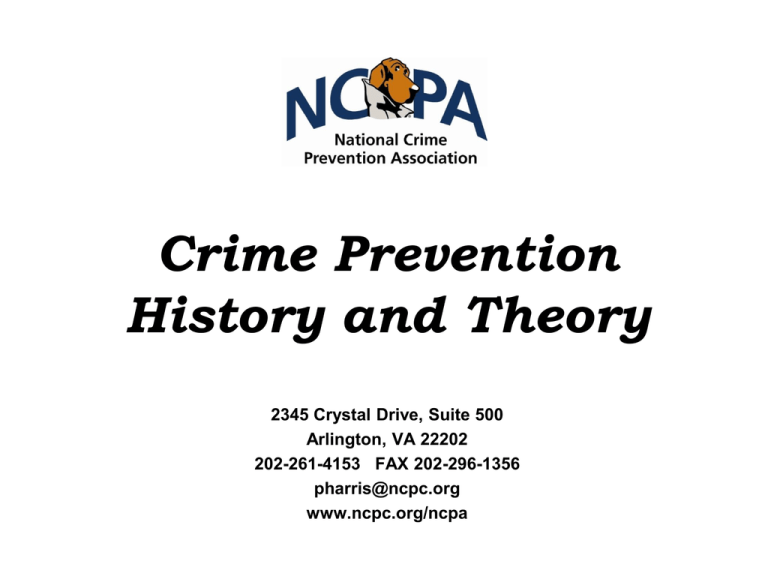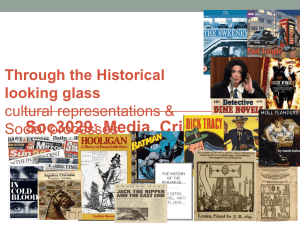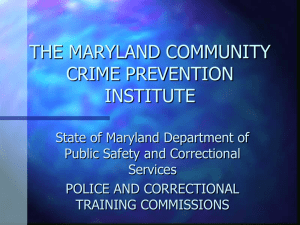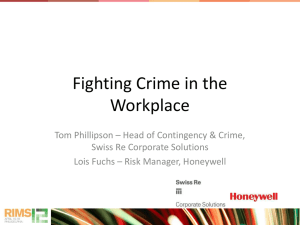Introduction to Policing and Prevention
advertisement

Crime Prevention History and Theory 2345 Crystal Drive, Suite 500 Arlington, VA 22202 202-261-4153 FAX 202-296-1356 pharris@ncpc.org www.ncpc.org/ncpa What Causes Crime - FBI 1. Population, density and degree of urbanization; 2. Population variations in composition and stability; 3. Economic conditions and employment 4. Mores, cultural conditions, education, and religion; 5. Family cohesiveness; 6. Climate, including seasonal weather conditions; What Causes Crime - FBI 7. Effective strength of the police force; 8. Police employment practices; 9. Policies of the courts, prosecutors and corrections; 10. Citizen attitudes toward crime and police; 11. Efficiency of police agencies 12. Crime reporting practices of citizens. Crime Prevention How do we prevent crime? Crime Prevention in Action Name some examples of crime prevention you have used or have seen in operation today. What was it ? What crime did it address? How did it work? Early Crime Prevention • The oldest known lock is estimated to be about 4,000 years old. It was found by archaeologists in the Khorsabad palace ruins in Iraq. The lock featured a large wooden bolt that secured a door, with several holes in its upper surface. • Heavily fortified castles of many countries stand as a permanent testament to the need to provide a safe community. • Early Crime Prevention • • • • During the Middle Ages, a system of "Reprisals" was used to discourage criminal behavior. By 1285, a "Watchman" system was initiated in London, based on the "hue and cry" of citizens. In 1655, Oliver Cromwell attempted to establish the first organized professional police force, based upon the watchman system. Early Crime Prevention • • • In the early 1700’s Jonathan Wild organized a gang of “thief takers” who were paid by results only. If they arrested a person for a crime, they received nothing from the authorities until a conviction resulted. In many cases a price was put on the head of a wanted criminal. The Night Watch - Rembrandt The Company of Captain Frans Banning Cocq and Lieutenant Willem van Ruytenhurch Early Law in America Laws Devine, Moral and Martial Sir Thomas Dale, Marshall and DeputiyGovernor Jamestown, Virginia June 22, 1611 the Captain of the watch, must have a special care of the safeguard and preservation of the Town or Fort committed to his charge, … that through his defect, negligence, or ignorance in his charge, he gives not opportunity to the enemy to execute any of his designs, for the damaging of the place or the Inhabitants. Early Crime Prevention Why do we eat with a fork and a blunt knife? 1669 - King Louis XIV of France banned pointed knives at the dinner table as a measure to reduce violence. Forks replaced pointed knives to spear food. Early Crime Prevention • In 1819, punishment was the main weapon against crime, with no fewer that 223 offenses were still punishable by death. • Because of the absence of police, the chances of a criminal being detected were very slim and those of his conviction even slimmer. • It became clear that severity of punishment was not an effective crime prevention method. • Early Crime Prevention • • • Historians give credit to Henry Fielding for taking the first positive steps for the formation of a responsible police organization. Later his half-brother, John Fielding, continued the work and is credited with having brought to the police service the concept of prevention. He said, “It is much better to prevent even one man from being a rogue than apprehending and bringing 40 to justice.” Robert Peel - Principles of Policing Much has been written about Sir Robert Peel and the development of the Metropolitan Police Act of 1829. It is clear that until this time very little had been done to place the police in a crime prevention role. Metropolitan Police Act of 1829 Part of the instructions to the officers were: • • It should be understood, at the outset, that the principal object to obtained is the prevention of crime. To this great end every effort of the police is to be directed. The test of police efficiency is the absence of crime and disorder, not the visible evidence of police action in dealing with it. Metropolitan Police Act of 1829 More of the instructions to the officers: • Security of persons and property, the preservation of the public tranquility, and all the other objects of a police establishment, can thus be better effected, than by the detection and punishment of the offender, after he has succeeded in committing the crime. Early Crime Prevention • • Unfortunaetley, these noble goals faded into the background as the police and public began to identify the success/failure of the police based on reported crimes reported and crimes cleared. It was more than a century later, in 1950, that British Police leaders realized something more positive had to be done in the area of crime prevention. Early Crime Prevention • • A campaign was officially opened by the Home Secretary on May 1, 1950, and it ran in various parts of the country until the autumn of 1951. Certain insurance companies, in cooperation with the Home Office, produced and distributed crime prevention material. Early Crime Prevention • • Because funding was not available this program was given low priority and it was not until 1963 that a formal training course in crime prevention was begun by the Home Office at Stafford. By this time, however, crime prevention training held high priority at the Home Office and by the end of 1970, 1,045 officers had attended the standard. Crime Prevention in America • • • In 1968, drawing on the British experience, John Klotter, Dean of the University of Louisville School of Police Administration began developing an American model for crime prevention. National Crime Prevention Institute - NCPI, established in Louisville, Kentucky in 1971. The National Sheriff’s Association began the Neighborhood Watch program in 1972. Crime Prevention in America • • In 1977, FBI Director Clarence Kelley went to The Advertising Council with a proposal for a crime prevention public service advertising campaign. The, LEAA, FBI, and the AFL-CIO formed a small planning group that included the National Sheriffs' Association and the International Association of Chiefs of Police. Crime Prevention in America • • In 1980, an animated dog in a trench coat became officially known as McGruff the Crime Dog®. In 1982, the National Crime Prevention Council was established to manage the McGruff campaign and promote crime prevention throughout the United States. Crime Prevention Coalition and McGruff Preliminary Images of the Crime Dog Crime Prevention Coalition and McGruff Jack Keil, with the advertising agency Saatchi & Saatchi, was the leader of the creative team that developed McGruff the Crime Dog. The Original McGruff He was the first person to utter the words, "Take A Bite Out Of Crime." Some Early Security Technology • • • In 1857, James Sargent invented the world’s first successful key-changeable combination lock. In 1861, Linus Yale, Jr., manufactured and patented a cylinder pin-tumbler lock. One year later he invented the modern combination lock. In 1873, James Sargent developed and patented a time lock mechanism. This lock became the prototype of those being used in contemporary bank vaults. Early Security Technology • • In 1942, the first closed circuit television (CCTV) system was installed by Siemens AG at Test Stand VII in Peenemunde, France, to observe the launch of German V2 rockets. Today, CCTV is used for security purposes and can be found anywhere from parking lots, office buildings, and grocery stores to school buses! Defining Crime Prevention Crime Prevention - Justice Model • Punitive (tertiary) • Corrective (secondary) • Mechanical or Protective (primary) Dr. Peter Lejins Crime Prevention - Punitive • criminal laws • police • Crime Stoppers • courts • jails and prisons Crime Prevention - Corrective • employment • education • counseling • mentoring • Head Start • Dare Crime Prevention - Protective • Neighborhood Watch • Community Policing • Public Education • CPTED • Homeland Security Crime Prevention Triangle Desire Ability Opportunity Crime Prevention Triangle Exercise Works as teams and list three steps that can be taken to address each of the three elements of the crime prevention triangle: Desire - Ability - Opportunity Each team will report back to the class. Crime Prevention Defined Crime Prevention is the anticipation, recognition and appraisal of a crime risk and the initiation of some action to remove or reduce the risk. Source: National Crime Prevention Institute - NCPI Crime Prevention Defined Crime Prevention is a pattern of attitudes and behaviors directed at reducing the threat of crime and enhancing the sense of safety and security, to positively influence the quality of life in our society, and to develop environments where crime cannot flourish. Source National Crime Prevention Council - 1990 Crime Prevention Defined Community Policing is an organization-wide philosophy and management approach that promotes partnerships; proactive problem solving and community engagement to address the causes of crime, fear of crime, and other community issues. Source Community Policing Initiative - 1990’s Crime Prevention • Crime prevention is proactive, rather than reactive. • Proactive policing attempts to prevent the crime from occurring in the first place. • Reactive policing responds to crime after it has occurred. Crime Prevention Motto The motto for crime prevention specialists in Virginia. Occasio Facit Furem "Opportunity makes the thief." 13th Century Proverb Crime Prevention is Proactive It stops crime from happening in the first place. Powers of the Police Force §15.2-1704 (Code of Virginia) The police force of a locality is hereby invested with all the power and authority which formerly belonged to the office of constable at common law and is responsible for • • • • • the prevention and detection of crime, the apprehension of criminals, the safeguard of life and property, the preservation of peace and the enforcement of state and local laws, regulations, and ordinances. Law Enforcement Officer (Code of Virginia) Law Enforcement Officer means any full-time or part-time employee of a police department or sheriff's office which is a part of or administered by the Commonwealth or any political subdivision thereof, and who is responsible for the prevention and detection of crime. The Law Enforcement Mission • Today the law enforcement element of the job is becoming secondary. • The order-maintenance, peace- preservation, and crime prevention elements of the job that are making more of a contribution to the overall quality of community life. Former Chief Jerry Oliver - Richmond Police Department Law Enforcement Mission The mission of the Philadelphia Police Department is to fight crime and the fear of crime, including terrorism, by working with our partners to enforce the laws, apprehend offenders, prevent crime from occurring, and improve the quality of life for all Philadelphians. Law Enforcement Mission Simple Mission Statement “To Serve and Protect.” Law Enforcement Mission Police Mission Exercise Works as teams and make a list of at least three reasons why crime prevention is important to the police mission. Each team will report back to the class. Opportunities to Commit Crime • unlocked or poorly locked doors • car keys left in the ignition • retail store layouts – shoplifting • computers – Internet • ATM and credit cards Opportunities to Commit Crime I can reduce the Major Crime rate in Virginia by 5% by implementing a crime prevention policy that does not involve any law enforcement participation? What crime is it? Opportunities to Commit Crime What type of crime prevention is this? How do we reduce the opportunity? Gasoline Drive Off Theft Gasoline Drive Off Theft Pay Before You Pump! NACS' State of the Industry report drive-offs cost the industry $300 million in 2005 - or $2,678 per each store selling gas. New Jersey State Law Dispensing Fuel or Pumping Gas No person shall dispense fuel at a gasoline station, unless the person is an attendant who has received instructions regarding the dispensing of fuel. Opportunity & Crime - 10 Principals 1. Opportunities play a role in causing all crime. 2. Crime opportunities are highly specific. 3. Crime opportunities are concentrated in time and space. 4. Crime opportunities depend on everyday movements. 5. One crime produces opportunities for another. Opportunity Makes the Thief, Felson & Clarke, 1998 http://www.homeoffice.gov.uk/rds/prgpdfs/fprs98.pdf Opportunity & Crime - 10 Principals 6. Some products offer more tempting crime opportunities. 7. Social and technological changes produce new crime opportunities. 8. Opportunities for crime can be reduced. 9. Reducing opportunities does not usually displace crime. 10. Focused opportunity reduction can produce wider declines in crime. Opportunity Makes the Thief, Felson & Clarke, 1998 http://www.homeoffice.gov.uk/rds/prgpdfs/fprs98.pdf Situational Crime Prevention Increase Effort Increase Risks Reduce Rewards Remove Excuses 1. Target Hardening door locks steering locks bandit screens 5. Entry/Exit Screening automatic ticket gates baggage screening merchandise tags 9. Target Removal removable car radio exact fare ATM cards 13. Rule Setting customs declaration income tax returns hotel registration 2. Access Control parking lot barriers fenced yards entry phones 6. Formal Surveillance red light cameras alarms security guards 10. Identifying Property car VIN #'s property marking personal ID numbers 14. Stimulating Conscience roadside speed clocks shoplifting is stealing signs idiots drink & drive ads 3. Deflecting Offenders bus stop placement tavern location street closures 7. Employee Surveillance pay phone location park attendants CCTV systems 11. Reducing Temptation graffiti cleaning rapid repair "bum-proof" bench 15. Controlling Disinhibitors drinking age laws ignition interlocks v-chips for TV 4. Controlling Facilitators credit card photo gun controls caller-ID 8. Natural Surveillance defensible space/CPTED street lighting cab driver I.D. 12. Denying Benefits pin #'s for car radios graffiti cleaning split merchandise tags 16. Facilitating Compliance easy library check out pay at the pump trash cans Crime Prevention Programs • • • • • • • • • • Neighborhood Watch Personal Safety Robbery Prevention School Safety Workplace Safety Auto Theft Prevention CPTED McGruff House Operation Identification and many others Options for Reducing Opportunity • Natural • Organized • Mechanical Natural Prevention We can create environments that can naturally encourage people to watch out. • Schools Organized Prevention We can organize people to provide for safety and security • Police Mechanical Prevention We can use Mechanical or electronic devices can be are used to secure property. • Video monitoring and locked gates. Mechanical Prevention Mechanical or electronic devices can be are used to create territoriality, surveillance or access control. Whatever works 4 D’s of Crime Prevention • Deny the criminal access to the target. • Deter the criminal from attacking. • Detect the criminal if he does attack. • Delay the criminal before he succeeds. his objective. Risk Management • Avoid the risk. • Reduce the risk. • Spread the risk. • Transfer the risk. • Accept the risk. Crime Prevention Is 1. everyone’s business 2. more than security 3. a responsibility of all levels of government 4. linked with solving social problems 5. cost-effective National Crime Prevention Council Crime Prevention Requires 6. a central position in law enforcement 7. cooperation among all elements of the community 8. education 9. tailoring to local needs and conditions 10. continual testing and improvement National Crime Prevention Council Crime Prevention - A New Idea? Enforcement First Crime Prevention can only be effective if aggressive and effective law enforcement is in place first. Is Crime Prevention Valuable? • It makes crime more difficult, discouraging people (especially) youth from getting involved in crime. • It frees up police resources. • It makes the police look more effective – many opportunistic crimes can’t be solved and make the police look bad. Crime Prevention Works Direct Deposit Reduced theft of retirement checks from the mail. Crime Prevention Works Bus Driver Robbery 1963 to 1968 bus driver robberies increased 50% and driver deaths increased 100%. Exact Fare Eliminated robbery and assaults of bus drivers. Crime Prevention Works Soft Body Armor • more than 3,000 lives saved • An officer who is NOT wearing armor is 14 times more likely to suffer a fatal injury than an officer who is wearing armor. (National Institute of Justice) Selling Crime Prevention Exercise Works as teams and identify two strategies that would best help sell crime prevention in your jurisdiction. Teams will report back to the class.









